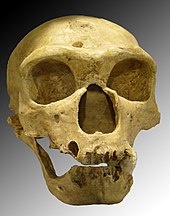نیاندەرتاڵ
ڕواڵەت

نیاندەرتاڵ (بە ئینگلیزی: Neanderthal) ئەو مرۆڤە کۆنانە بوون کە نزیکەی ٤٠,٠٠٠ ساڵ لەمەوپێش لەناوچوون.[١][٢][٣][٤][٥] وا دیارە کە ئەوان لە ئەورووپاوە سەریان ھەڵداوە و دواتریش بە ناوچەکانی باشووری ڕۆژا و ناوەڕاست و باکووری ئاسیادا بڵاوبوونەتەوە. ھەر لە ئاسیادا، ئەوان ھەزاران کەلوپەلی بەردینیان لەدوای خۆیان بەجێھێشتووە. مرۆڤی ھاوچەرخ ٩٩.٧٪ی دی ئێن ئەیەکەیان دەچێتەوە سەر نیاندەرتاڵەکان.
ئەمانەش بیبینە
[دەستکاری]سەرچاوەکان
[دەستکاری]- ^ «The timing and spatiotemporal patterning of Neanderthal disappearance». Nature. 512 (7514): 306–09. 2014. Bibcode:٢٠١٤Natur.٥١٢..٣٠٦H. doi:١٠.١٠٣٨/nature١٣٦٢١. PMID ٢٥١٤٣١١٣.
We show that the Mousterian [the Neanderthal tool-making tradition] ended by 41,030–39,260 calibrated years BP (at 95.4% probability) across Europe. We also demonstrate that succeeding 'transitional' archaeological industries, one of which has been linked with Neanderthals (Châtelperronian), end at a similar time.
{{cite journal}}:|bibcode=length بپشکنە (یارمەتی); نرخی|doi=بپشکنە (یارمەتی); نرخی|pmid=بپشکنە (یارمەتی); پارامەتری نەناسراوی|authors=چاوپۆشیی لێ کرا (یارمەتی) - ^ «European Middle and Upper Palaeolithic radiocarbon dates are often older than they look: problems with previous dates and some remedies» (PDF). Antiquity. 85 (327): 235–49. 2011. doi:١٠.١٠١٧/s٠٠٠٣٥٩٨x٠٠٠٦٧٥٧٠.
Few events of European prehistory are more important than the transition from ancient to modern humans around 40 000 years ago, a period that unfortunately lies near the limit of radiocarbon dating. This paper shows that as many as 70 per cent of the oldest radiocarbon dates in the literature may be too young, due to contamination by modern carbon.
{{cite journal}}: نرخی|doi=بپشکنە (یارمەتی); پارامەتری نەناسراوی|authors=چاوپۆشیی لێ کرا (یارمەتی) - ^ «Revised age of late Neanderthal occupation and the end of the Middle Paleolithic in the northern Caucasus». Proceedings of the National Academy of Sciences USA. 108 (21): 8611–16. 2011. Bibcode:٢٠١١PNAS..١٠٨.٨٦١١P. doi:١٠.١٠٧٣/pnas.١٠١٨٩٣٨١٠٨.
The direct date of the fossil (39,700 ± 1,100 14C BP) is in good agreement with the probability distribution function, indicating at a high level of probability that Neanderthals did not survive at Mezmaiskaya Cave after 39 ka cal BP. [...] This challenges previous claims for late Neanderthal survival in the northern Caucasus. [...] Our results confirm the lack of reliably dated Neanderthal fossils younger than ≈40 ka cal BP in any other region of Western Eurasia, including the Caucasus.
{{cite journal}}:|bibcode=length بپشکنە (یارمەتی); نرخی|doi=بپشکنە (یارمەتی); پارامەتری نەناسراوی|authors=چاوپۆشیی لێ کرا (یارمەتی) - ^ «New evidence of early Neanderthal disappearance in the Iberian Peninsula» (PDF). Journal of Human Evolution. 75: 16–27. 2014. doi:١٠.١٠١٦/j.jhevol.٢٠١٤.٠٦.٠٠٢. PMID ٢٥٠١٦٥٦٥.
{{cite journal}}: نرخی|doi=بپشکنە (یارمەتی); نرخی|pmid=بپشکنە (یارمەتی); پارامەتری نەناسراوی|authors=چاوپۆشیی لێ کرا (یارمەتی) - ^ McKie، Robin (٢ی حوزەیرانی ٢٠١٣). «Why did the Neanderthals die out?». The Guardian. لە ٦ی نیسانی ٢٠١٧ ھێنراوە.
"It was once thought we appeared in Europe around 35,000 years ago and that we coexisted with Neanderthals for thousands of years after that. They may have hung on in pockets – including caves in Gibraltar – until 28,000 years ago [said Chris Stringer]" Previous research on Neanderthal sites which suggested that they were more recent than 40,000 years old appears to be wrong," said Stringer. "That is a key finding that will be discussed at the conference."[...] However, scientists have set out to get round these problems. At Oxford University, scientists led by Tom Higham have developed new methods to remove contamination and have been able to make much more precise radiocarbon dating for this period.
| ئەم ژینناسی وتارە کۆلکەیەکە. دەتوانیت بە فراوانکردنی یارمەتیی ویکیپیدیا بدەیت. |
| کۆمنزی ویکیمیدیا، میدیای پەیوەندیدار بە نیاندەرتاڵ تێدایە. |
